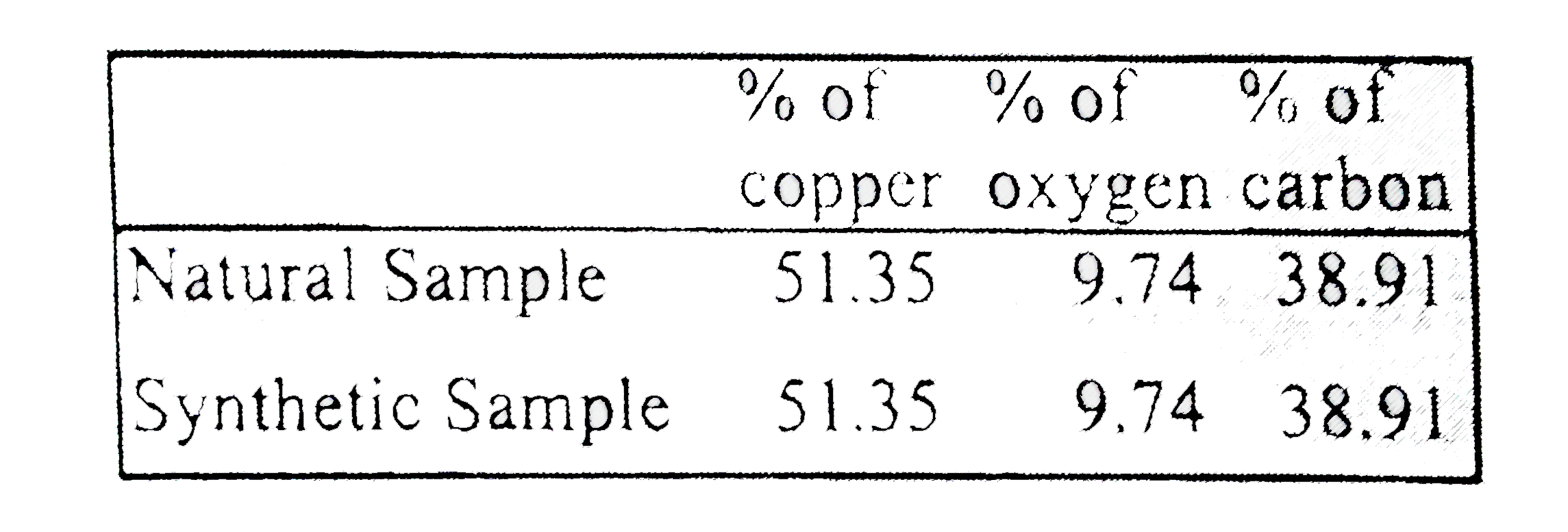12.976 g of lead combines with 2.004 g of oxygen to form PbO2.PbO2 can also be produced by heating lead nitrate and it was found that the percentage of oxygen present in PbO2 is 13.38 %. With the help of given informations, illustrate the law of constant composition.
In both cases percentage of oxygen is the same, so the law of constant composition is illustrated.
Topper's Solved these Questions
- SOME BASIC CONCEPTS OF CHEMISTRY BOOK - AAKASH INSTITUTECHAPTER - SOME BASIC CONCEPTS OF CHEMISTRY EXERCISE - ASSIGNMENT SECTION A (Objective Type Questions (One option is correct))
46 Videos
- SOME BASIC CONCEPTS OF CHEMISTRY BOOK - AAKASH INSTITUTECHAPTER - SOME BASIC CONCEPTS OF CHEMISTRY EXERCISE - ASSIGNMENT SECTION B (Objective Type Questions (One option is correct))
25 Videos
- SOME BASIC CONCEPTS OF CHEMISTRY BOOK - AAKASH INSTITUTECHAPTER - SOME BASIC CONCEPTS OF CHEMISTRY EXERCISE - ASSIGNMENT SECTION J (Aakash Challenges Questions)
10 Videos
- SOME BASIC CONCEPT OF CHEMISTRYBOOK - AAKASH INSTITUTECHAPTER - SOME BASIC CONCEPT OF CHEMISTRYEXERCISE - ASSIGNMENT( SECTION - D) Assertion-Reason Type Questions
15 Videos
- STATES OF MATTERBOOK - AAKASH INSTITUTECHAPTER - STATES OF MATTEREXERCISE - ASSIGNMENT (SECTION-D)
15 Videos
Similar Questions
6.488 g of lead combine directly with 1.002g of oxygen to form lead peroxide (PbO2). Lead peroxide is also produced by heating lead nitrate and it was found that the percentage of oxygen present in lead peroxides 13.38 percent. Use these data to illustrate the law of constant composition.
View Solution4.90 g of KClO3 when heated produced 1.92 g of oxygen and the residue (KCl) left behind weighs 2.96 g. Show that these results illustrate the law of conservation of mass.
View Solution
Knowledge Check
3g of hydrocarbon on combustion with 11.2 g of oxygen produce 8.8 g of CO2 and 5.4g of H2O. The data illustrate the law of:
Aconservation of massBmultiple proportionsCconstant proportionsDreciprocal proportions6g of a hydrocarbon on combustion in excess of oxygen produces 17.6g of CO2 and 10.8g of H2O. The data illustrates the law of :
Aconservation of massBmultiple proportionsCconstant proportionsDreciprocal proportions3 g of a hydrocarbon on combustion with excess of oxygen produces 8.8 g of CO2 and 5.4 g of H2O. The data illustrates the law of
Aconservation of massBmultiple proportionsCconstant proportionsDreciprocal proportions.
1g of oxygen combines with 0.1260g of hydrogen to form H2O. 1g of nitrogen combines with 0.2160g of hydrogen to form NH3. Predict the weight of oxygen required to combine with 1g of nitrogen to form an oxide.
View SolutionThis law was given by, a French chemist , Joseph Proust. He stated that a given compound always contains exactly the same proportion of elements by weight.
Proust worked with two samples of curpic carbonate- one of which was of natural origin and the other was synthetic one . He found that the composition of elements present in it was for both the samples as shown below:
Thus, irrespective of the source, a given compound always contains same elements in the same proportion. The validity of this law has been confrmed by various experiments. It is sometimes also reffered to as Law of constant composition.
Limitation:
This law is not applicable if the compound is formed from different isotopes of an element . The two isotopes of carbon C-12 and C-14 form carbondioxide C12O2 and C14O2 . The ratio of C : O is 12 : 32 and 14 : 32 respectively .It is not a constant ratio.
6.488 g lead with 1.002 g oxygen to form an oxide. This oxide is also obtained by heating Pb(NO3)2, It is found that % of lead in this oxide is 86.62 .Show that these date illustrate the law of definite proportions.

View SolutionIn the reaction, Hydrogen(g)+ Oxygen (g) → watervapour, the ratio of volumes is 2:1:2:. This illustrates the law of
View Solution3g of a hydrocarbons on combusion in excess of oxygen produces 8.8g of CO2 and 5.4g of H2O. The data illustrates the law of:
View Solution3 g of a hydrocarbon on combustion in excess of oxygen produces 8.8g of CO2 and 5.4 g of H2O. The data illustrates the law of:
View Solution
